Digital Skills and Professional Development: Self-Reflection Report
VerifiedAdded on 2022/07/22
|10
|3802
|467
Report
AI Summary
This report delves into the crucial aspects of digital skills and professional development in the modern business landscape. It begins by exploring the advancement of business automation technologies and their impact on the workforce, emphasizing the need for continuous digital skill development. The report then outlines essential digital skills required for professional competence, providing examples across various industries and modern workplaces. Furthermore, it incorporates a self-reflection analysis of management and leadership skills, using the Gibbs cycle model to evaluate strengths and areas for improvement. Finally, the report culminates in a personal development plan designed to enhance effective management and leadership capabilities, offering a comprehensive guide for professionals seeking to thrive in a technology-driven environment.
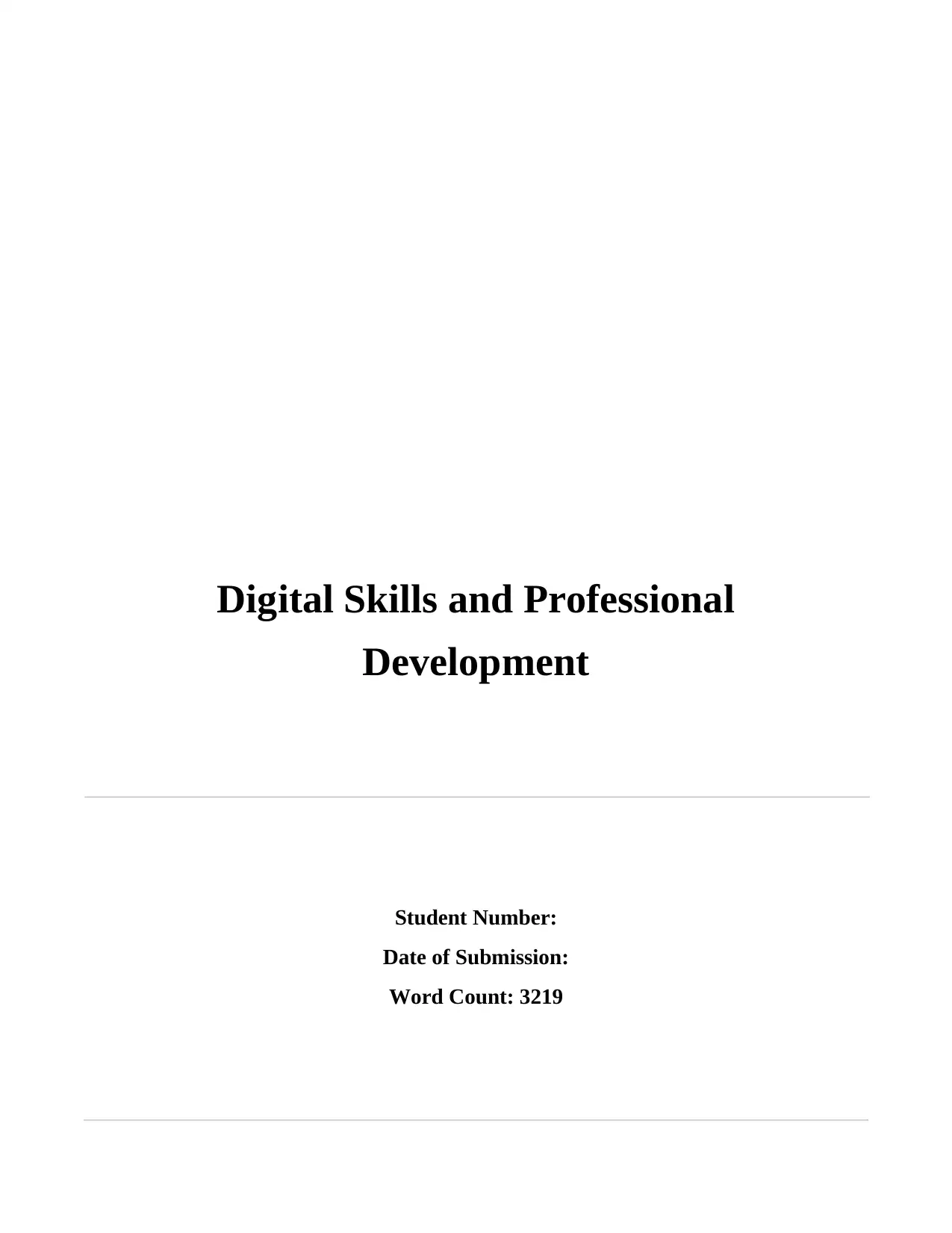
Digital Skills and Professional
Development
Student Number:
Date of Submission:
Word Count: 3219
Development
Student Number:
Date of Submission:
Word Count: 3219
Paraphrase This Document
Need a fresh take? Get an instant paraphrase of this document with our AI Paraphraser
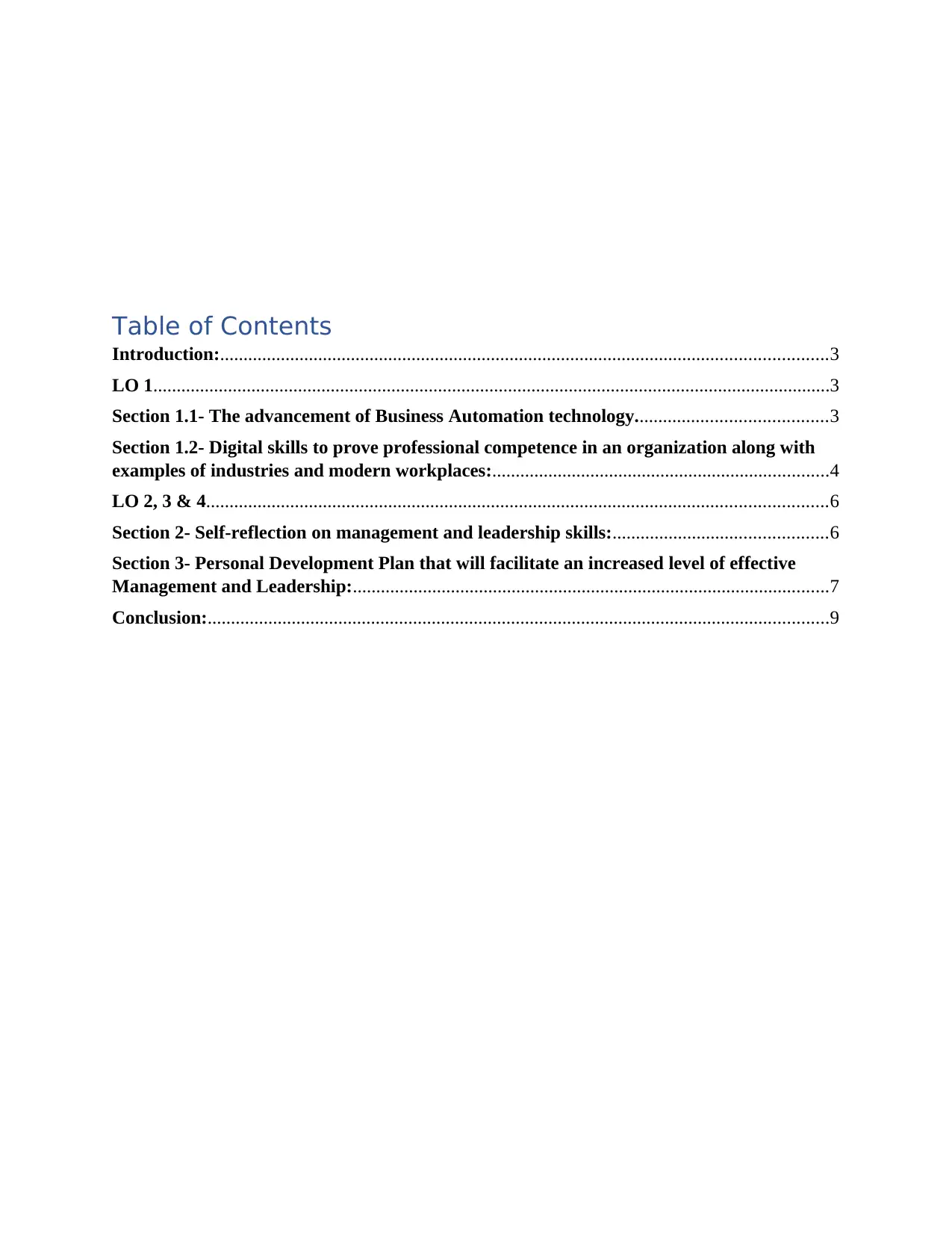
Table of Contents
Introduction:..................................................................................................................................3
LO 1.................................................................................................................................................3
Section 1.1- The advancement of Business Automation technology.........................................3
Section 1.2- Digital skills to prove professional competence in an organization along with
examples of industries and modern workplaces:........................................................................4
LO 2, 3 & 4.....................................................................................................................................6
Section 2- Self-reflection on management and leadership skills:..............................................6
Section 3- Personal Development Plan that will facilitate an increased level of effective
Management and Leadership:......................................................................................................7
Conclusion:.....................................................................................................................................9
Introduction:..................................................................................................................................3
LO 1.................................................................................................................................................3
Section 1.1- The advancement of Business Automation technology.........................................3
Section 1.2- Digital skills to prove professional competence in an organization along with
examples of industries and modern workplaces:........................................................................4
LO 2, 3 & 4.....................................................................................................................................6
Section 2- Self-reflection on management and leadership skills:..............................................6
Section 3- Personal Development Plan that will facilitate an increased level of effective
Management and Leadership:......................................................................................................7
Conclusion:.....................................................................................................................................9
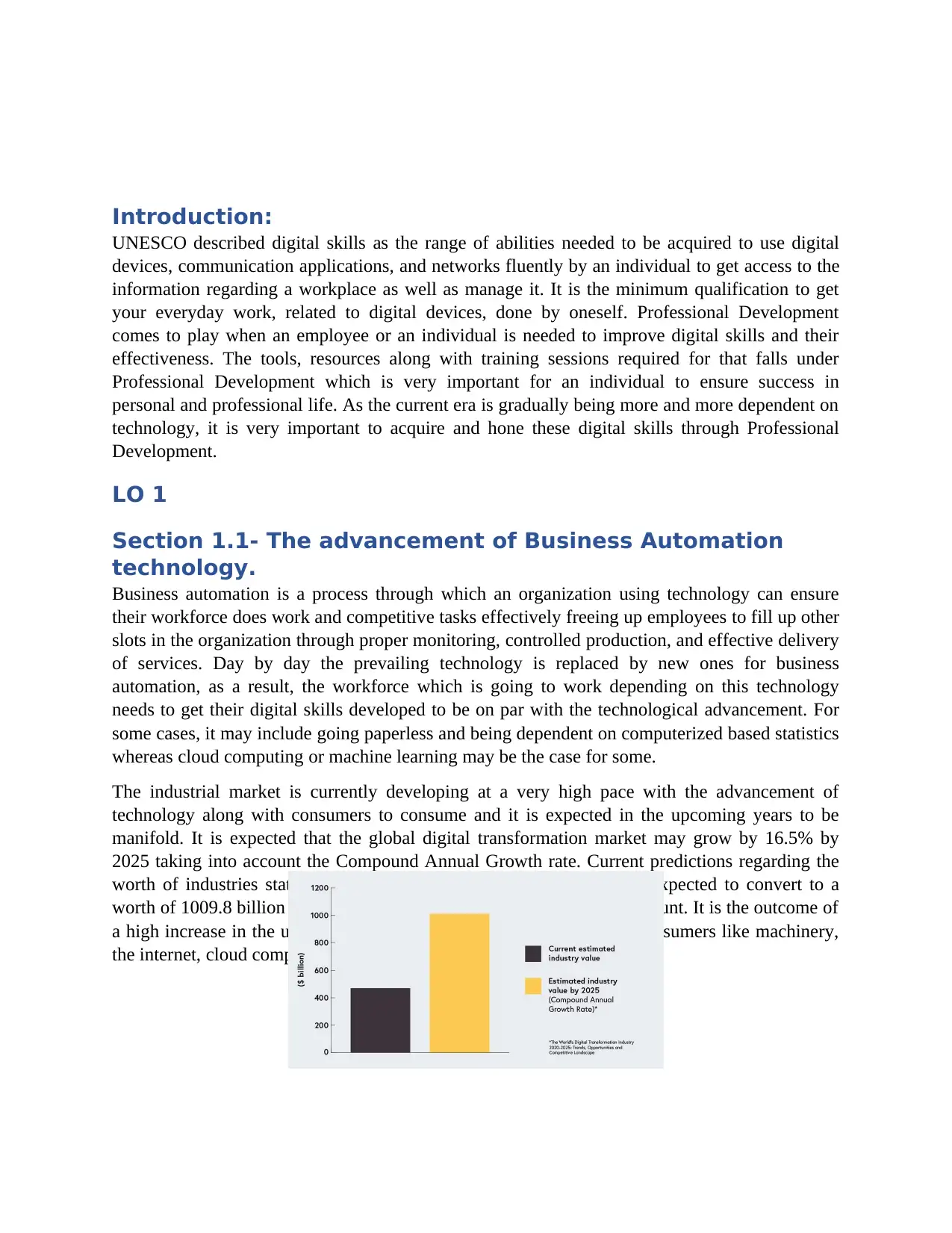
Introduction:
UNESCO described digital skills as the range of abilities needed to be acquired to use digital
devices, communication applications, and networks fluently by an individual to get access to the
information regarding a workplace as well as manage it. It is the minimum qualification to get
your everyday work, related to digital devices, done by oneself. Professional Development
comes to play when an employee or an individual is needed to improve digital skills and their
effectiveness. The tools, resources along with training sessions required for that falls under
Professional Development which is very important for an individual to ensure success in
personal and professional life. As the current era is gradually being more and more dependent on
technology, it is very important to acquire and hone these digital skills through Professional
Development.
LO 1
Section 1.1- The advancement of Business Automation
technology.
Business automation is a process through which an organization using technology can ensure
their workforce does work and competitive tasks effectively freeing up employees to fill up other
slots in the organization through proper monitoring, controlled production, and effective delivery
of services. Day by day the prevailing technology is replaced by new ones for business
automation, as a result, the workforce which is going to work depending on this technology
needs to get their digital skills developed to be on par with the technological advancement. For
some cases, it may include going paperless and being dependent on computerized based statistics
whereas cloud computing or machine learning may be the case for some.
The industrial market is currently developing at a very high pace with the advancement of
technology along with consumers to consume and it is expected in the upcoming years to be
manifold. It is expected that the global digital transformation market may grow by 16.5% by
2025 taking into account the Compound Annual Growth rate. Current predictions regarding the
worth of industries state it’s worth around 469.8 billion USD and is expected to convert to a
worth of 1009.8 billion USD by 2025, which is more than its double amount. It is the outcome of
a high increase in the use of technologies both by the producers and consumers like machinery,
the internet, cloud computing, and many more.
UNESCO described digital skills as the range of abilities needed to be acquired to use digital
devices, communication applications, and networks fluently by an individual to get access to the
information regarding a workplace as well as manage it. It is the minimum qualification to get
your everyday work, related to digital devices, done by oneself. Professional Development
comes to play when an employee or an individual is needed to improve digital skills and their
effectiveness. The tools, resources along with training sessions required for that falls under
Professional Development which is very important for an individual to ensure success in
personal and professional life. As the current era is gradually being more and more dependent on
technology, it is very important to acquire and hone these digital skills through Professional
Development.
LO 1
Section 1.1- The advancement of Business Automation
technology.
Business automation is a process through which an organization using technology can ensure
their workforce does work and competitive tasks effectively freeing up employees to fill up other
slots in the organization through proper monitoring, controlled production, and effective delivery
of services. Day by day the prevailing technology is replaced by new ones for business
automation, as a result, the workforce which is going to work depending on this technology
needs to get their digital skills developed to be on par with the technological advancement. For
some cases, it may include going paperless and being dependent on computerized based statistics
whereas cloud computing or machine learning may be the case for some.
The industrial market is currently developing at a very high pace with the advancement of
technology along with consumers to consume and it is expected in the upcoming years to be
manifold. It is expected that the global digital transformation market may grow by 16.5% by
2025 taking into account the Compound Annual Growth rate. Current predictions regarding the
worth of industries state it’s worth around 469.8 billion USD and is expected to convert to a
worth of 1009.8 billion USD by 2025, which is more than its double amount. It is the outcome of
a high increase in the use of technologies both by the producers and consumers like machinery,
the internet, cloud computing, and many more.
⊘ This is a preview!⊘
Do you want full access?
Subscribe today to unlock all pages.

Trusted by 1+ million students worldwide
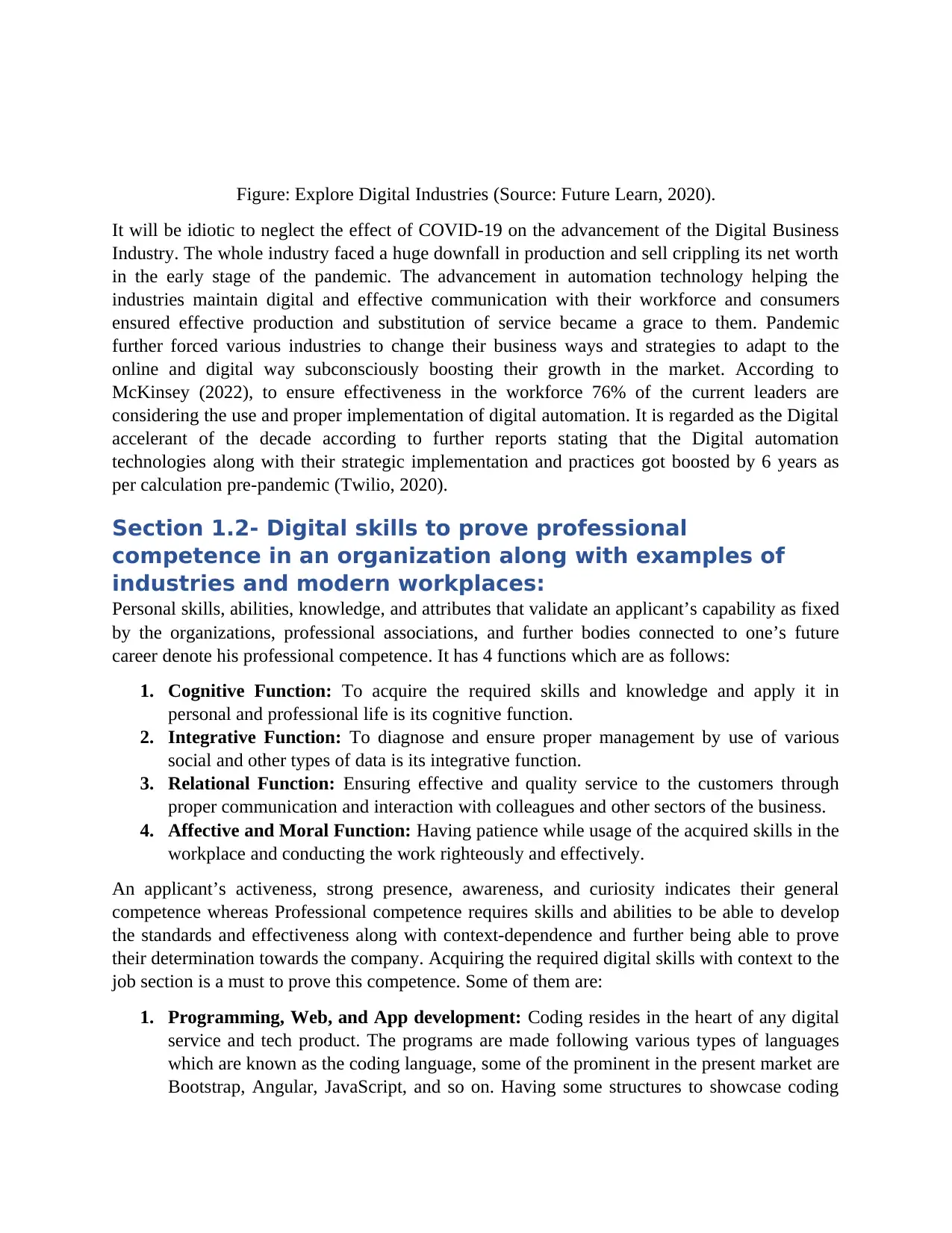
Figure: Explore Digital Industries (Source: Future Learn, 2020).
It will be idiotic to neglect the effect of COVID-19 on the advancement of the Digital Business
Industry. The whole industry faced a huge downfall in production and sell crippling its net worth
in the early stage of the pandemic. The advancement in automation technology helping the
industries maintain digital and effective communication with their workforce and consumers
ensured effective production and substitution of service became a grace to them. Pandemic
further forced various industries to change their business ways and strategies to adapt to the
online and digital way subconsciously boosting their growth in the market. According to
McKinsey (2022), to ensure effectiveness in the workforce 76% of the current leaders are
considering the use and proper implementation of digital automation. It is regarded as the Digital
accelerant of the decade according to further reports stating that the Digital automation
technologies along with their strategic implementation and practices got boosted by 6 years as
per calculation pre-pandemic (Twilio, 2020).
Section 1.2- Digital skills to prove professional
competence in an organization along with examples of
industries and modern workplaces:
Personal skills, abilities, knowledge, and attributes that validate an applicant’s capability as fixed
by the organizations, professional associations, and further bodies connected to one’s future
career denote his professional competence. It has 4 functions which are as follows:
1. Cognitive Function: To acquire the required skills and knowledge and apply it in
personal and professional life is its cognitive function.
2. Integrative Function: To diagnose and ensure proper management by use of various
social and other types of data is its integrative function.
3. Relational Function: Ensuring effective and quality service to the customers through
proper communication and interaction with colleagues and other sectors of the business.
4. Affective and Moral Function: Having patience while usage of the acquired skills in the
workplace and conducting the work righteously and effectively.
An applicant’s activeness, strong presence, awareness, and curiosity indicates their general
competence whereas Professional competence requires skills and abilities to be able to develop
the standards and effectiveness along with context-dependence and further being able to prove
their determination towards the company. Acquiring the required digital skills with context to the
job section is a must to prove this competence. Some of them are:
1. Programming, Web, and App development: Coding resides in the heart of any digital
service and tech product. The programs are made following various types of languages
which are known as the coding language, some of the prominent in the present market are
Bootstrap, Angular, JavaScript, and so on. Having some structures to showcase coding
It will be idiotic to neglect the effect of COVID-19 on the advancement of the Digital Business
Industry. The whole industry faced a huge downfall in production and sell crippling its net worth
in the early stage of the pandemic. The advancement in automation technology helping the
industries maintain digital and effective communication with their workforce and consumers
ensured effective production and substitution of service became a grace to them. Pandemic
further forced various industries to change their business ways and strategies to adapt to the
online and digital way subconsciously boosting their growth in the market. According to
McKinsey (2022), to ensure effectiveness in the workforce 76% of the current leaders are
considering the use and proper implementation of digital automation. It is regarded as the Digital
accelerant of the decade according to further reports stating that the Digital automation
technologies along with their strategic implementation and practices got boosted by 6 years as
per calculation pre-pandemic (Twilio, 2020).
Section 1.2- Digital skills to prove professional
competence in an organization along with examples of
industries and modern workplaces:
Personal skills, abilities, knowledge, and attributes that validate an applicant’s capability as fixed
by the organizations, professional associations, and further bodies connected to one’s future
career denote his professional competence. It has 4 functions which are as follows:
1. Cognitive Function: To acquire the required skills and knowledge and apply it in
personal and professional life is its cognitive function.
2. Integrative Function: To diagnose and ensure proper management by use of various
social and other types of data is its integrative function.
3. Relational Function: Ensuring effective and quality service to the customers through
proper communication and interaction with colleagues and other sectors of the business.
4. Affective and Moral Function: Having patience while usage of the acquired skills in the
workplace and conducting the work righteously and effectively.
An applicant’s activeness, strong presence, awareness, and curiosity indicates their general
competence whereas Professional competence requires skills and abilities to be able to develop
the standards and effectiveness along with context-dependence and further being able to prove
their determination towards the company. Acquiring the required digital skills with context to the
job section is a must to prove this competence. Some of them are:
1. Programming, Web, and App development: Coding resides in the heart of any digital
service and tech product. The programs are made following various types of languages
which are known as the coding language, some of the prominent in the present market are
Bootstrap, Angular, JavaScript, and so on. Having some structures to showcase coding
Paraphrase This Document
Need a fresh take? Get an instant paraphrase of this document with our AI Paraphraser
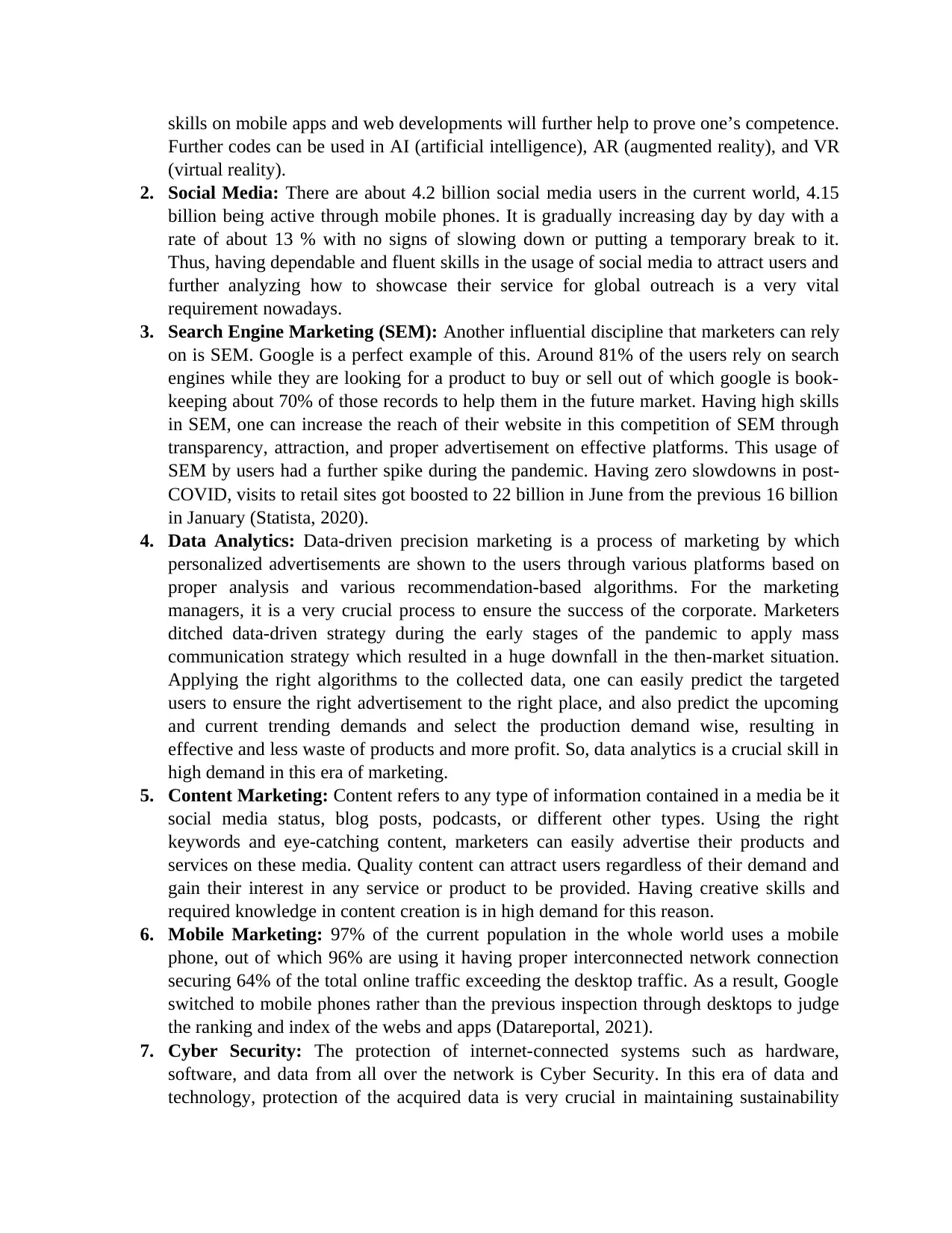
skills on mobile apps and web developments will further help to prove one’s competence.
Further codes can be used in AI (artificial intelligence), AR (augmented reality), and VR
(virtual reality).
2. Social Media: There are about 4.2 billion social media users in the current world, 4.15
billion being active through mobile phones. It is gradually increasing day by day with a
rate of about 13 % with no signs of slowing down or putting a temporary break to it.
Thus, having dependable and fluent skills in the usage of social media to attract users and
further analyzing how to showcase their service for global outreach is a very vital
requirement nowadays.
3. Search Engine Marketing (SEM): Another influential discipline that marketers can rely
on is SEM. Google is a perfect example of this. Around 81% of the users rely on search
engines while they are looking for a product to buy or sell out of which google is book-
keeping about 70% of those records to help them in the future market. Having high skills
in SEM, one can increase the reach of their website in this competition of SEM through
transparency, attraction, and proper advertisement on effective platforms. This usage of
SEM by users had a further spike during the pandemic. Having zero slowdowns in post-
COVID, visits to retail sites got boosted to 22 billion in June from the previous 16 billion
in January (Statista, 2020).
4. Data Analytics: Data-driven precision marketing is a process of marketing by which
personalized advertisements are shown to the users through various platforms based on
proper analysis and various recommendation-based algorithms. For the marketing
managers, it is a very crucial process to ensure the success of the corporate. Marketers
ditched data-driven strategy during the early stages of the pandemic to apply mass
communication strategy which resulted in a huge downfall in the then-market situation.
Applying the right algorithms to the collected data, one can easily predict the targeted
users to ensure the right advertisement to the right place, and also predict the upcoming
and current trending demands and select the production demand wise, resulting in
effective and less waste of products and more profit. So, data analytics is a crucial skill in
high demand in this era of marketing.
5. Content Marketing: Content refers to any type of information contained in a media be it
social media status, blog posts, podcasts, or different other types. Using the right
keywords and eye-catching content, marketers can easily advertise their products and
services on these media. Quality content can attract users regardless of their demand and
gain their interest in any service or product to be provided. Having creative skills and
required knowledge in content creation is in high demand for this reason.
6. Mobile Marketing: 97% of the current population in the whole world uses a mobile
phone, out of which 96% are using it having proper interconnected network connection
securing 64% of the total online traffic exceeding the desktop traffic. As a result, Google
switched to mobile phones rather than the previous inspection through desktops to judge
the ranking and index of the webs and apps (Datareportal, 2021).
7. Cyber Security: The protection of internet-connected systems such as hardware,
software, and data from all over the network is Cyber Security. In this era of data and
technology, protection of the acquired data is very crucial in maintaining sustainability
Further codes can be used in AI (artificial intelligence), AR (augmented reality), and VR
(virtual reality).
2. Social Media: There are about 4.2 billion social media users in the current world, 4.15
billion being active through mobile phones. It is gradually increasing day by day with a
rate of about 13 % with no signs of slowing down or putting a temporary break to it.
Thus, having dependable and fluent skills in the usage of social media to attract users and
further analyzing how to showcase their service for global outreach is a very vital
requirement nowadays.
3. Search Engine Marketing (SEM): Another influential discipline that marketers can rely
on is SEM. Google is a perfect example of this. Around 81% of the users rely on search
engines while they are looking for a product to buy or sell out of which google is book-
keeping about 70% of those records to help them in the future market. Having high skills
in SEM, one can increase the reach of their website in this competition of SEM through
transparency, attraction, and proper advertisement on effective platforms. This usage of
SEM by users had a further spike during the pandemic. Having zero slowdowns in post-
COVID, visits to retail sites got boosted to 22 billion in June from the previous 16 billion
in January (Statista, 2020).
4. Data Analytics: Data-driven precision marketing is a process of marketing by which
personalized advertisements are shown to the users through various platforms based on
proper analysis and various recommendation-based algorithms. For the marketing
managers, it is a very crucial process to ensure the success of the corporate. Marketers
ditched data-driven strategy during the early stages of the pandemic to apply mass
communication strategy which resulted in a huge downfall in the then-market situation.
Applying the right algorithms to the collected data, one can easily predict the targeted
users to ensure the right advertisement to the right place, and also predict the upcoming
and current trending demands and select the production demand wise, resulting in
effective and less waste of products and more profit. So, data analytics is a crucial skill in
high demand in this era of marketing.
5. Content Marketing: Content refers to any type of information contained in a media be it
social media status, blog posts, podcasts, or different other types. Using the right
keywords and eye-catching content, marketers can easily advertise their products and
services on these media. Quality content can attract users regardless of their demand and
gain their interest in any service or product to be provided. Having creative skills and
required knowledge in content creation is in high demand for this reason.
6. Mobile Marketing: 97% of the current population in the whole world uses a mobile
phone, out of which 96% are using it having proper interconnected network connection
securing 64% of the total online traffic exceeding the desktop traffic. As a result, Google
switched to mobile phones rather than the previous inspection through desktops to judge
the ranking and index of the webs and apps (Datareportal, 2021).
7. Cyber Security: The protection of internet-connected systems such as hardware,
software, and data from all over the network is Cyber Security. In this era of data and
technology, protection of the acquired data is very crucial in maintaining sustainability
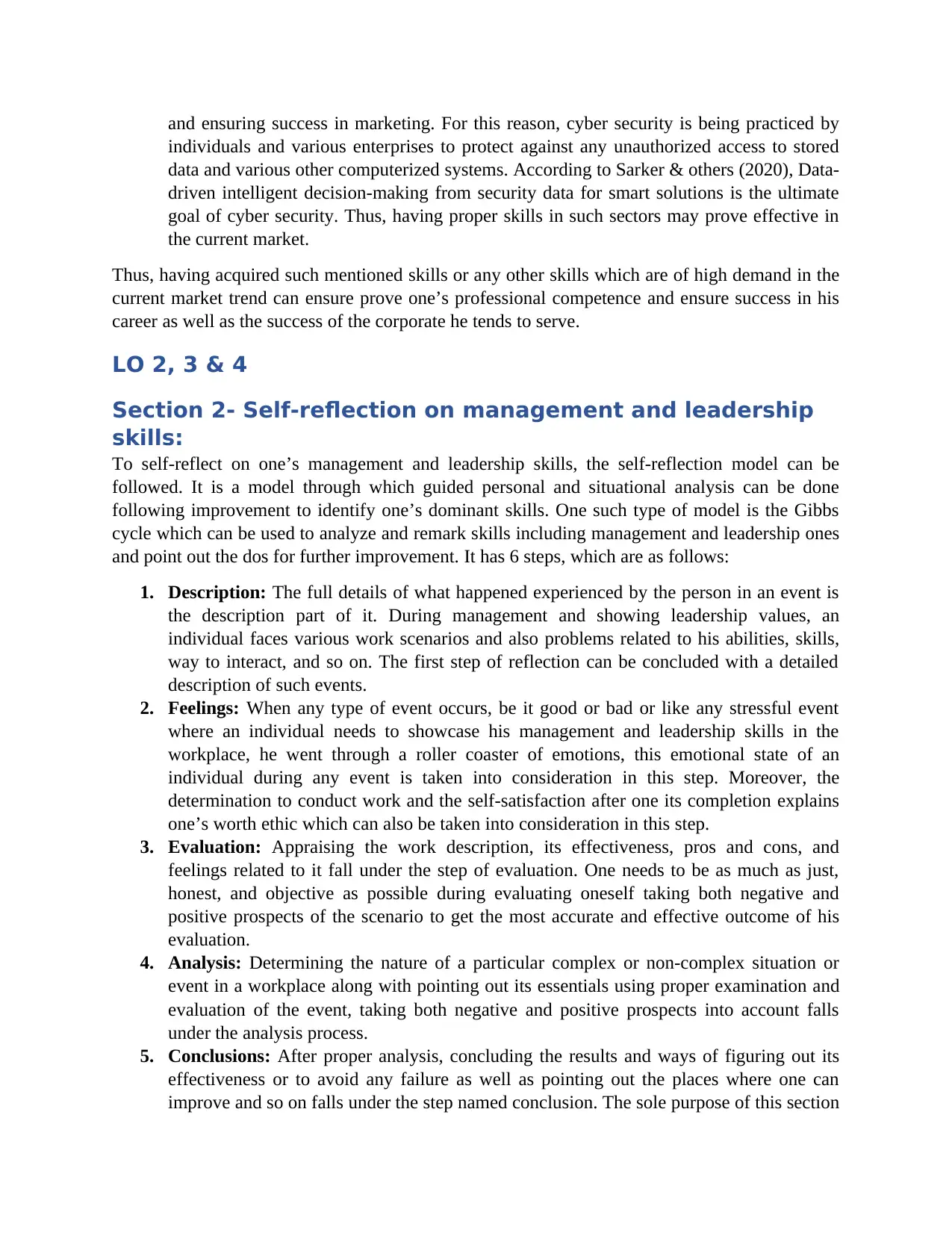
and ensuring success in marketing. For this reason, cyber security is being practiced by
individuals and various enterprises to protect against any unauthorized access to stored
data and various other computerized systems. According to Sarker & others (2020), Data-
driven intelligent decision-making from security data for smart solutions is the ultimate
goal of cyber security. Thus, having proper skills in such sectors may prove effective in
the current market.
Thus, having acquired such mentioned skills or any other skills which are of high demand in the
current market trend can ensure prove one’s professional competence and ensure success in his
career as well as the success of the corporate he tends to serve.
LO 2, 3 & 4
Section 2- Self-reflection on management and leadership
skills:
To self-reflect on one’s management and leadership skills, the self-reflection model can be
followed. It is a model through which guided personal and situational analysis can be done
following improvement to identify one’s dominant skills. One such type of model is the Gibbs
cycle which can be used to analyze and remark skills including management and leadership ones
and point out the dos for further improvement. It has 6 steps, which are as follows:
1. Description: The full details of what happened experienced by the person in an event is
the description part of it. During management and showing leadership values, an
individual faces various work scenarios and also problems related to his abilities, skills,
way to interact, and so on. The first step of reflection can be concluded with a detailed
description of such events.
2. Feelings: When any type of event occurs, be it good or bad or like any stressful event
where an individual needs to showcase his management and leadership skills in the
workplace, he went through a roller coaster of emotions, this emotional state of an
individual during any event is taken into consideration in this step. Moreover, the
determination to conduct work and the self-satisfaction after one its completion explains
one’s worth ethic which can also be taken into consideration in this step.
3. Evaluation: Appraising the work description, its effectiveness, pros and cons, and
feelings related to it fall under the step of evaluation. One needs to be as much as just,
honest, and objective as possible during evaluating oneself taking both negative and
positive prospects of the scenario to get the most accurate and effective outcome of his
evaluation.
4. Analysis: Determining the nature of a particular complex or non-complex situation or
event in a workplace along with pointing out its essentials using proper examination and
evaluation of the event, taking both negative and positive prospects into account falls
under the analysis process.
5. Conclusions: After proper analysis, concluding the results and ways of figuring out its
effectiveness or to avoid any failure as well as pointing out the places where one can
improve and so on falls under the step named conclusion. The sole purpose of this section
individuals and various enterprises to protect against any unauthorized access to stored
data and various other computerized systems. According to Sarker & others (2020), Data-
driven intelligent decision-making from security data for smart solutions is the ultimate
goal of cyber security. Thus, having proper skills in such sectors may prove effective in
the current market.
Thus, having acquired such mentioned skills or any other skills which are of high demand in the
current market trend can ensure prove one’s professional competence and ensure success in his
career as well as the success of the corporate he tends to serve.
LO 2, 3 & 4
Section 2- Self-reflection on management and leadership
skills:
To self-reflect on one’s management and leadership skills, the self-reflection model can be
followed. It is a model through which guided personal and situational analysis can be done
following improvement to identify one’s dominant skills. One such type of model is the Gibbs
cycle which can be used to analyze and remark skills including management and leadership ones
and point out the dos for further improvement. It has 6 steps, which are as follows:
1. Description: The full details of what happened experienced by the person in an event is
the description part of it. During management and showing leadership values, an
individual faces various work scenarios and also problems related to his abilities, skills,
way to interact, and so on. The first step of reflection can be concluded with a detailed
description of such events.
2. Feelings: When any type of event occurs, be it good or bad or like any stressful event
where an individual needs to showcase his management and leadership skills in the
workplace, he went through a roller coaster of emotions, this emotional state of an
individual during any event is taken into consideration in this step. Moreover, the
determination to conduct work and the self-satisfaction after one its completion explains
one’s worth ethic which can also be taken into consideration in this step.
3. Evaluation: Appraising the work description, its effectiveness, pros and cons, and
feelings related to it fall under the step of evaluation. One needs to be as much as just,
honest, and objective as possible during evaluating oneself taking both negative and
positive prospects of the scenario to get the most accurate and effective outcome of his
evaluation.
4. Analysis: Determining the nature of a particular complex or non-complex situation or
event in a workplace along with pointing out its essentials using proper examination and
evaluation of the event, taking both negative and positive prospects into account falls
under the analysis process.
5. Conclusions: After proper analysis, concluding the results and ways of figuring out its
effectiveness or to avoid any failure as well as pointing out the places where one can
improve and so on falls under the step named conclusion. The sole purpose of this section
⊘ This is a preview!⊘
Do you want full access?
Subscribe today to unlock all pages.

Trusted by 1+ million students worldwide
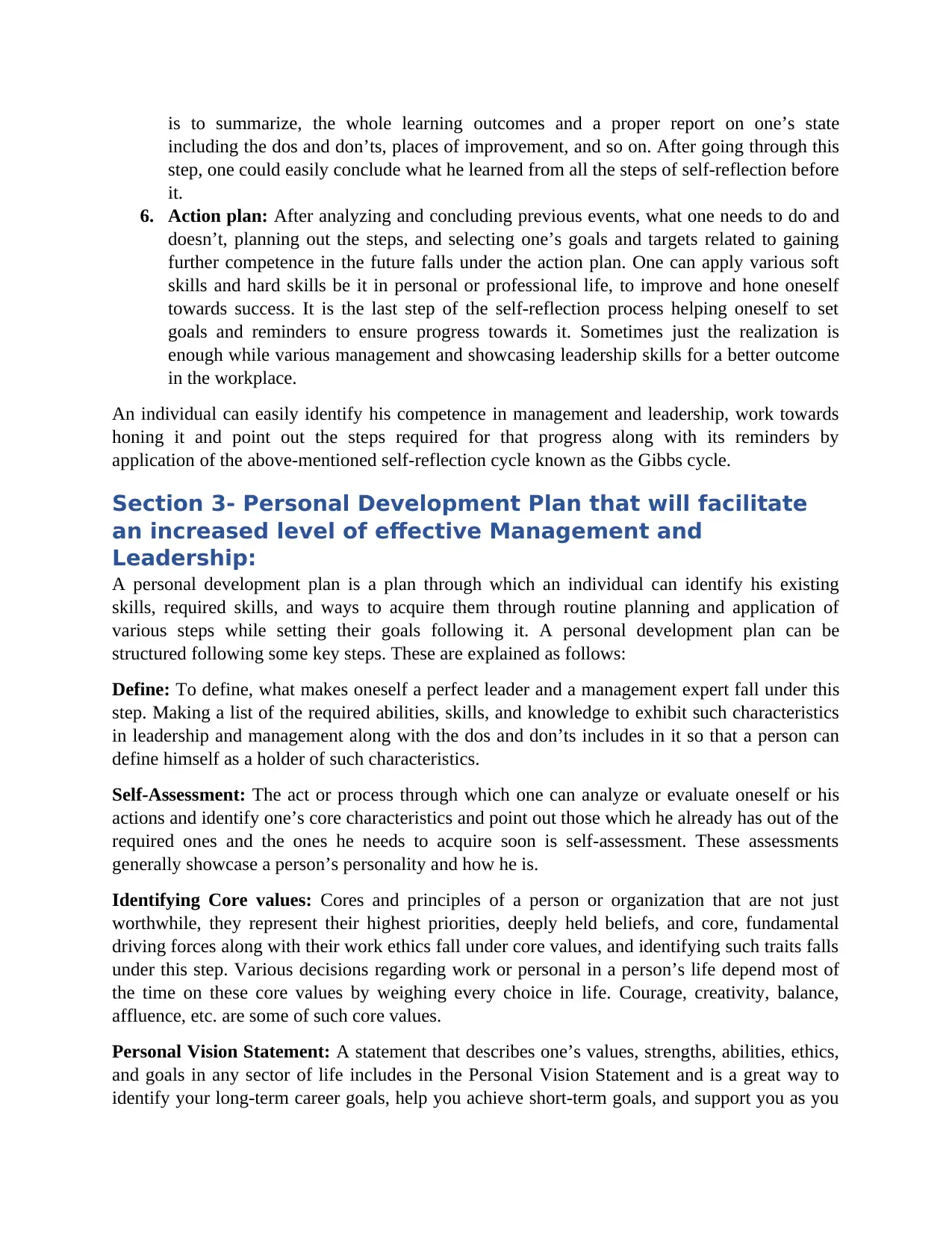
is to summarize, the whole learning outcomes and a proper report on one’s state
including the dos and don’ts, places of improvement, and so on. After going through this
step, one could easily conclude what he learned from all the steps of self-reflection before
it.
6. Action plan: After analyzing and concluding previous events, what one needs to do and
doesn’t, planning out the steps, and selecting one’s goals and targets related to gaining
further competence in the future falls under the action plan. One can apply various soft
skills and hard skills be it in personal or professional life, to improve and hone oneself
towards success. It is the last step of the self-reflection process helping oneself to set
goals and reminders to ensure progress towards it. Sometimes just the realization is
enough while various management and showcasing leadership skills for a better outcome
in the workplace.
An individual can easily identify his competence in management and leadership, work towards
honing it and point out the steps required for that progress along with its reminders by
application of the above-mentioned self-reflection cycle known as the Gibbs cycle.
Section 3- Personal Development Plan that will facilitate
an increased level of effective Management and
Leadership:
A personal development plan is a plan through which an individual can identify his existing
skills, required skills, and ways to acquire them through routine planning and application of
various steps while setting their goals following it. A personal development plan can be
structured following some key steps. These are explained as follows:
Define: To define, what makes oneself a perfect leader and a management expert fall under this
step. Making a list of the required abilities, skills, and knowledge to exhibit such characteristics
in leadership and management along with the dos and don’ts includes in it so that a person can
define himself as a holder of such characteristics.
Self-Assessment: The act or process through which one can analyze or evaluate oneself or his
actions and identify one’s core characteristics and point out those which he already has out of the
required ones and the ones he needs to acquire soon is self-assessment. These assessments
generally showcase a person’s personality and how he is.
Identifying Core values: Cores and principles of a person or organization that are not just
worthwhile, they represent their highest priorities, deeply held beliefs, and core, fundamental
driving forces along with their work ethics fall under core values, and identifying such traits falls
under this step. Various decisions regarding work or personal in a person’s life depend most of
the time on these core values by weighing every choice in life. Courage, creativity, balance,
affluence, etc. are some of such core values.
Personal Vision Statement: A statement that describes one’s values, strengths, abilities, ethics,
and goals in any sector of life includes in the Personal Vision Statement and is a great way to
identify your long-term career goals, help you achieve short-term goals, and support you as you
including the dos and don’ts, places of improvement, and so on. After going through this
step, one could easily conclude what he learned from all the steps of self-reflection before
it.
6. Action plan: After analyzing and concluding previous events, what one needs to do and
doesn’t, planning out the steps, and selecting one’s goals and targets related to gaining
further competence in the future falls under the action plan. One can apply various soft
skills and hard skills be it in personal or professional life, to improve and hone oneself
towards success. It is the last step of the self-reflection process helping oneself to set
goals and reminders to ensure progress towards it. Sometimes just the realization is
enough while various management and showcasing leadership skills for a better outcome
in the workplace.
An individual can easily identify his competence in management and leadership, work towards
honing it and point out the steps required for that progress along with its reminders by
application of the above-mentioned self-reflection cycle known as the Gibbs cycle.
Section 3- Personal Development Plan that will facilitate
an increased level of effective Management and
Leadership:
A personal development plan is a plan through which an individual can identify his existing
skills, required skills, and ways to acquire them through routine planning and application of
various steps while setting their goals following it. A personal development plan can be
structured following some key steps. These are explained as follows:
Define: To define, what makes oneself a perfect leader and a management expert fall under this
step. Making a list of the required abilities, skills, and knowledge to exhibit such characteristics
in leadership and management along with the dos and don’ts includes in it so that a person can
define himself as a holder of such characteristics.
Self-Assessment: The act or process through which one can analyze or evaluate oneself or his
actions and identify one’s core characteristics and point out those which he already has out of the
required ones and the ones he needs to acquire soon is self-assessment. These assessments
generally showcase a person’s personality and how he is.
Identifying Core values: Cores and principles of a person or organization that are not just
worthwhile, they represent their highest priorities, deeply held beliefs, and core, fundamental
driving forces along with their work ethics fall under core values, and identifying such traits falls
under this step. Various decisions regarding work or personal in a person’s life depend most of
the time on these core values by weighing every choice in life. Courage, creativity, balance,
affluence, etc. are some of such core values.
Personal Vision Statement: A statement that describes one’s values, strengths, abilities, ethics,
and goals in any sector of life includes in the Personal Vision Statement and is a great way to
identify your long-term career goals, help you achieve short-term goals, and support you as you
Paraphrase This Document
Need a fresh take? Get an instant paraphrase of this document with our AI Paraphraser
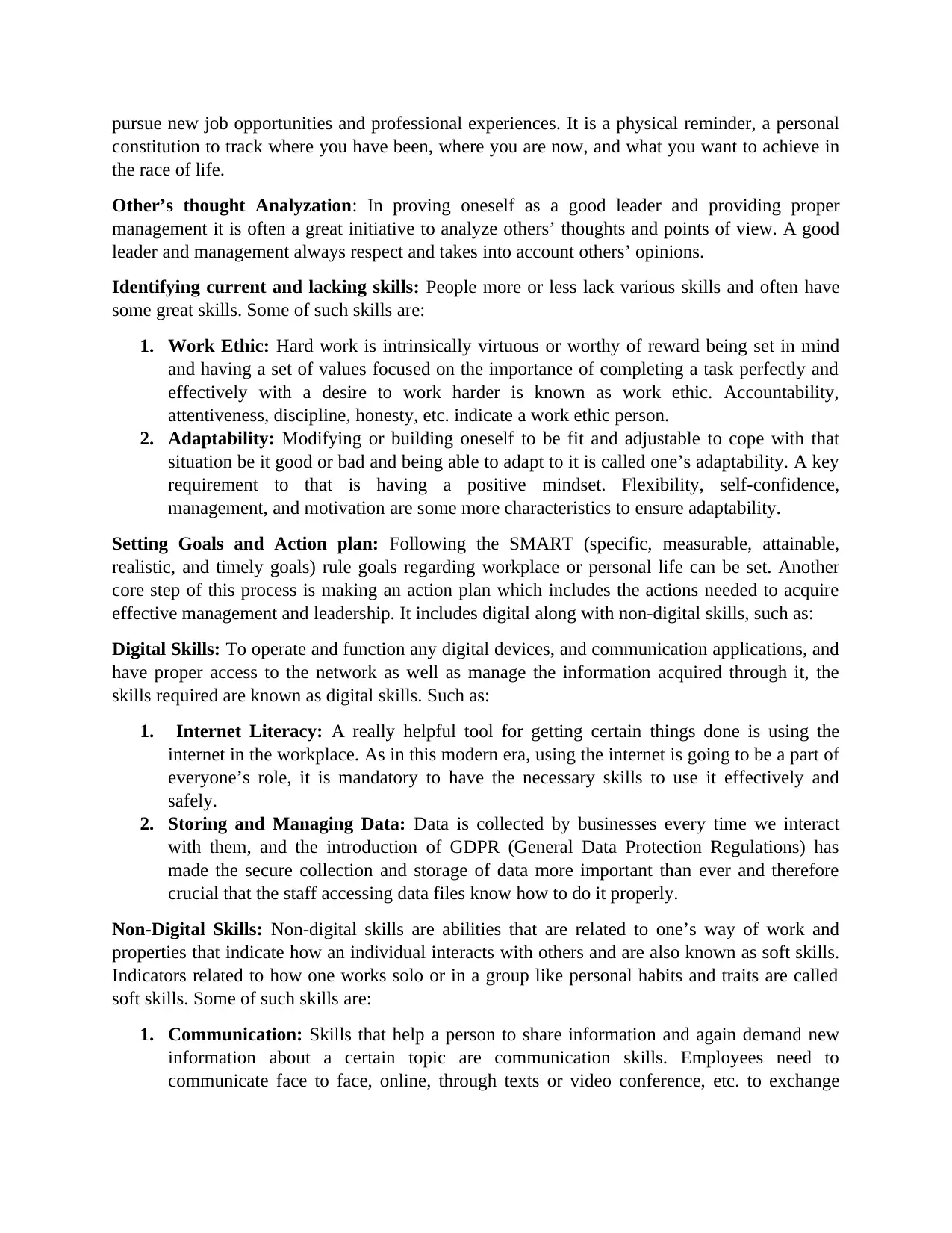
pursue new job opportunities and professional experiences. It is a physical reminder, a personal
constitution to track where you have been, where you are now, and what you want to achieve in
the race of life.
Other’s thought Analyzation: In proving oneself as a good leader and providing proper
management it is often a great initiative to analyze others’ thoughts and points of view. A good
leader and management always respect and takes into account others’ opinions.
Identifying current and lacking skills: People more or less lack various skills and often have
some great skills. Some of such skills are:
1. Work Ethic: Hard work is intrinsically virtuous or worthy of reward being set in mind
and having a set of values focused on the importance of completing a task perfectly and
effectively with a desire to work harder is known as work ethic. Accountability,
attentiveness, discipline, honesty, etc. indicate a work ethic person.
2. Adaptability: Modifying or building oneself to be fit and adjustable to cope with that
situation be it good or bad and being able to adapt to it is called one’s adaptability. A key
requirement to that is having a positive mindset. Flexibility, self-confidence,
management, and motivation are some more characteristics to ensure adaptability.
Setting Goals and Action plan: Following the SMART (specific, measurable, attainable,
realistic, and timely goals) rule goals regarding workplace or personal life can be set. Another
core step of this process is making an action plan which includes the actions needed to acquire
effective management and leadership. It includes digital along with non-digital skills, such as:
Digital Skills: To operate and function any digital devices, and communication applications, and
have proper access to the network as well as manage the information acquired through it, the
skills required are known as digital skills. Such as:
1. Internet Literacy: A really helpful tool for getting certain things done is using the
internet in the workplace. As in this modern era, using the internet is going to be a part of
everyone’s role, it is mandatory to have the necessary skills to use it effectively and
safely.
2. Storing and Managing Data: Data is collected by businesses every time we interact
with them, and the introduction of GDPR (General Data Protection Regulations) has
made the secure collection and storage of data more important than ever and therefore
crucial that the staff accessing data files know how to do it properly.
Non-Digital Skills: Non-digital skills are abilities that are related to one’s way of work and
properties that indicate how an individual interacts with others and are also known as soft skills.
Indicators related to how one works solo or in a group like personal habits and traits are called
soft skills. Some of such skills are:
1. Communication: Skills that help a person to share information and again demand new
information about a certain topic are communication skills. Employees need to
communicate face to face, online, through texts or video conference, etc. to exchange
constitution to track where you have been, where you are now, and what you want to achieve in
the race of life.
Other’s thought Analyzation: In proving oneself as a good leader and providing proper
management it is often a great initiative to analyze others’ thoughts and points of view. A good
leader and management always respect and takes into account others’ opinions.
Identifying current and lacking skills: People more or less lack various skills and often have
some great skills. Some of such skills are:
1. Work Ethic: Hard work is intrinsically virtuous or worthy of reward being set in mind
and having a set of values focused on the importance of completing a task perfectly and
effectively with a desire to work harder is known as work ethic. Accountability,
attentiveness, discipline, honesty, etc. indicate a work ethic person.
2. Adaptability: Modifying or building oneself to be fit and adjustable to cope with that
situation be it good or bad and being able to adapt to it is called one’s adaptability. A key
requirement to that is having a positive mindset. Flexibility, self-confidence,
management, and motivation are some more characteristics to ensure adaptability.
Setting Goals and Action plan: Following the SMART (specific, measurable, attainable,
realistic, and timely goals) rule goals regarding workplace or personal life can be set. Another
core step of this process is making an action plan which includes the actions needed to acquire
effective management and leadership. It includes digital along with non-digital skills, such as:
Digital Skills: To operate and function any digital devices, and communication applications, and
have proper access to the network as well as manage the information acquired through it, the
skills required are known as digital skills. Such as:
1. Internet Literacy: A really helpful tool for getting certain things done is using the
internet in the workplace. As in this modern era, using the internet is going to be a part of
everyone’s role, it is mandatory to have the necessary skills to use it effectively and
safely.
2. Storing and Managing Data: Data is collected by businesses every time we interact
with them, and the introduction of GDPR (General Data Protection Regulations) has
made the secure collection and storage of data more important than ever and therefore
crucial that the staff accessing data files know how to do it properly.
Non-Digital Skills: Non-digital skills are abilities that are related to one’s way of work and
properties that indicate how an individual interacts with others and are also known as soft skills.
Indicators related to how one works solo or in a group like personal habits and traits are called
soft skills. Some of such skills are:
1. Communication: Skills that help a person to share information and again demand new
information about a certain topic are communication skills. Employees need to
communicate face to face, online, through texts or video conference, etc. to exchange
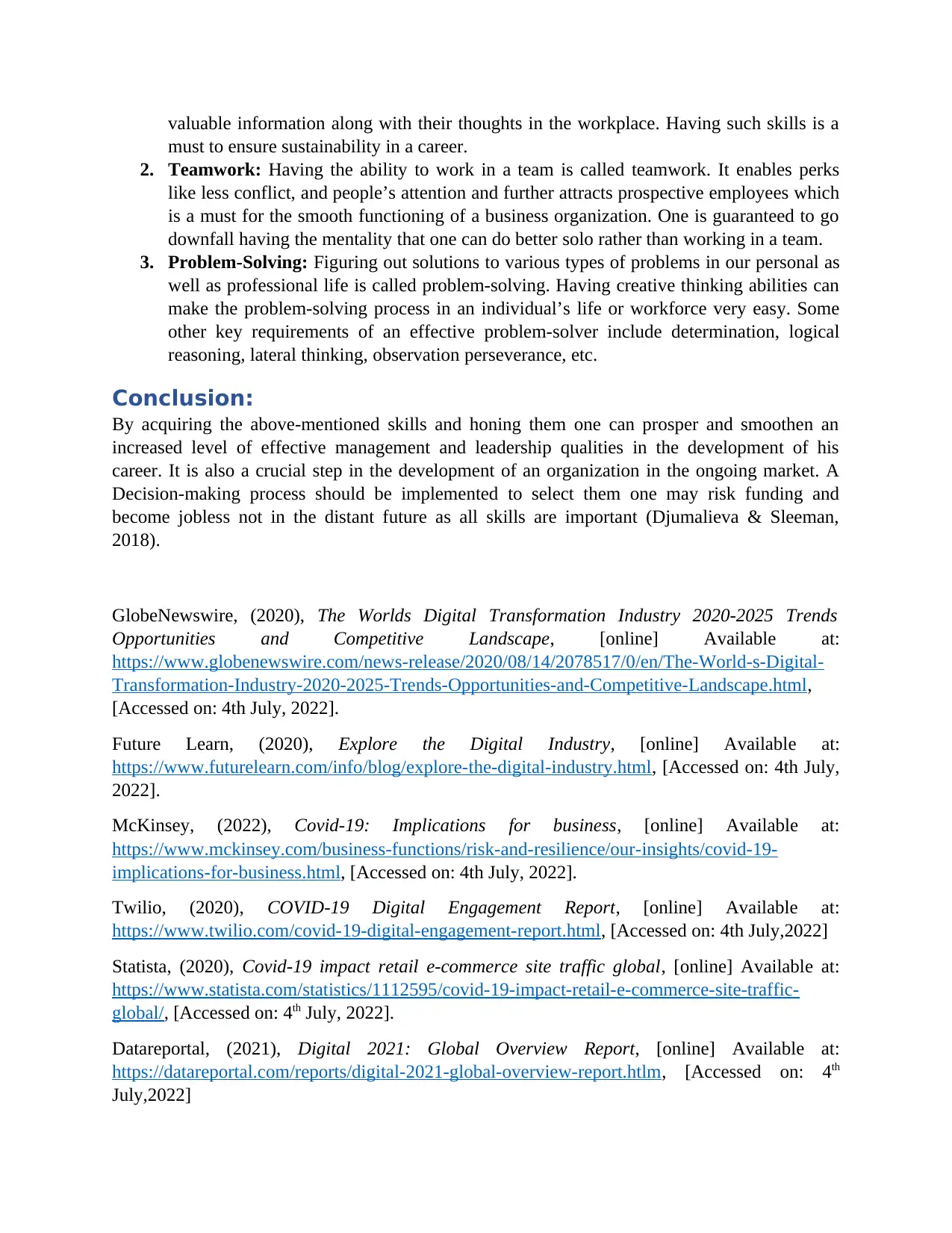
valuable information along with their thoughts in the workplace. Having such skills is a
must to ensure sustainability in a career.
2. Teamwork: Having the ability to work in a team is called teamwork. It enables perks
like less conflict, and people’s attention and further attracts prospective employees which
is a must for the smooth functioning of a business organization. One is guaranteed to go
downfall having the mentality that one can do better solo rather than working in a team.
3. Problem-Solving: Figuring out solutions to various types of problems in our personal as
well as professional life is called problem-solving. Having creative thinking abilities can
make the problem-solving process in an individual’s life or workforce very easy. Some
other key requirements of an effective problem-solver include determination, logical
reasoning, lateral thinking, observation perseverance, etc.
Conclusion:
By acquiring the above-mentioned skills and honing them one can prosper and smoothen an
increased level of effective management and leadership qualities in the development of his
career. It is also a crucial step in the development of an organization in the ongoing market. A
Decision-making process should be implemented to select them one may risk funding and
become jobless not in the distant future as all skills are important (Djumalieva & Sleeman,
2018).
GlobeNewswire, (2020), The Worlds Digital Transformation Industry 2020-2025 Trends
Opportunities and Competitive Landscape, [online] Available at:
https://www.globenewswire.com/news-release/2020/08/14/2078517/0/en/The-World-s-Digital-
Transformation-Industry-2020-2025-Trends-Opportunities-and-Competitive-Landscape.html,
[Accessed on: 4th July, 2022].
Future Learn, (2020), Explore the Digital Industry, [online] Available at:
https://www.futurelearn.com/info/blog/explore-the-digital-industry.html, [Accessed on: 4th July,
2022].
McKinsey, (2022), Covid-19: Implications for business, [online] Available at:
https://www.mckinsey.com/business-functions/risk-and-resilience/our-insights/covid-19-
implications-for-business.html, [Accessed on: 4th July, 2022].
Twilio, (2020), COVID-19 Digital Engagement Report, [online] Available at:
https://www.twilio.com/covid-19-digital-engagement-report.html, [Accessed on: 4th July,2022]
Statista, (2020), Covid-19 impact retail e-commerce site traffic global, [online] Available at:
https://www.statista.com/statistics/1112595/covid-19-impact-retail-e-commerce-site-traffic-
global/, [Accessed on: 4th July, 2022].
Datareportal, (2021), Digital 2021: Global Overview Report, [online] Available at:
https://datareportal.com/reports/digital-2021-global-overview-report.htlm, [Accessed on: 4th
July,2022]
must to ensure sustainability in a career.
2. Teamwork: Having the ability to work in a team is called teamwork. It enables perks
like less conflict, and people’s attention and further attracts prospective employees which
is a must for the smooth functioning of a business organization. One is guaranteed to go
downfall having the mentality that one can do better solo rather than working in a team.
3. Problem-Solving: Figuring out solutions to various types of problems in our personal as
well as professional life is called problem-solving. Having creative thinking abilities can
make the problem-solving process in an individual’s life or workforce very easy. Some
other key requirements of an effective problem-solver include determination, logical
reasoning, lateral thinking, observation perseverance, etc.
Conclusion:
By acquiring the above-mentioned skills and honing them one can prosper and smoothen an
increased level of effective management and leadership qualities in the development of his
career. It is also a crucial step in the development of an organization in the ongoing market. A
Decision-making process should be implemented to select them one may risk funding and
become jobless not in the distant future as all skills are important (Djumalieva & Sleeman,
2018).
GlobeNewswire, (2020), The Worlds Digital Transformation Industry 2020-2025 Trends
Opportunities and Competitive Landscape, [online] Available at:
https://www.globenewswire.com/news-release/2020/08/14/2078517/0/en/The-World-s-Digital-
Transformation-Industry-2020-2025-Trends-Opportunities-and-Competitive-Landscape.html,
[Accessed on: 4th July, 2022].
Future Learn, (2020), Explore the Digital Industry, [online] Available at:
https://www.futurelearn.com/info/blog/explore-the-digital-industry.html, [Accessed on: 4th July,
2022].
McKinsey, (2022), Covid-19: Implications for business, [online] Available at:
https://www.mckinsey.com/business-functions/risk-and-resilience/our-insights/covid-19-
implications-for-business.html, [Accessed on: 4th July, 2022].
Twilio, (2020), COVID-19 Digital Engagement Report, [online] Available at:
https://www.twilio.com/covid-19-digital-engagement-report.html, [Accessed on: 4th July,2022]
Statista, (2020), Covid-19 impact retail e-commerce site traffic global, [online] Available at:
https://www.statista.com/statistics/1112595/covid-19-impact-retail-e-commerce-site-traffic-
global/, [Accessed on: 4th July, 2022].
Datareportal, (2021), Digital 2021: Global Overview Report, [online] Available at:
https://datareportal.com/reports/digital-2021-global-overview-report.htlm, [Accessed on: 4th
July,2022]
⊘ This is a preview!⊘
Do you want full access?
Subscribe today to unlock all pages.

Trusted by 1+ million students worldwide

Sarker, I.H., Kayes, A.S.M., Badsha, S., Alqahtani, H., Watters, P. and Ng, A., 2020.
Cybersecurity data science: an overview from machine learning perspective. Journal of Big
data, 7(1), pp.1-29.
Djumalieva, J. and Sleeman, C., 2018. Which digital skills do you need?. London. Recuperado
de https://www. nesta. org. uk/report/which-digital-skills-do-you-really-need.
Cybersecurity data science: an overview from machine learning perspective. Journal of Big
data, 7(1), pp.1-29.
Djumalieva, J. and Sleeman, C., 2018. Which digital skills do you need?. London. Recuperado
de https://www. nesta. org. uk/report/which-digital-skills-do-you-really-need.
1 out of 10
Related Documents
Your All-in-One AI-Powered Toolkit for Academic Success.
+13062052269
info@desklib.com
Available 24*7 on WhatsApp / Email
![[object Object]](/_next/static/media/star-bottom.7253800d.svg)
Unlock your academic potential
Copyright © 2020–2025 A2Z Services. All Rights Reserved. Developed and managed by ZUCOL.





